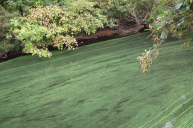It turns out that California's Clear Lake isn't so clear. The California lake has a bit of an algae problem. How bad you're probably wondering? Well, the very green algae is visible from space. NASA took an image of the lake, and it's very very green. Despite it's color, Clear Lake remains a popular tourist spot.
Located 120 miles from San Francisco, Clear Lake has a couple of distinctions. It is California's largest natural freshwater lake, and it is also the oldest lake in North America. That makes the algae threat that much worse. NASA took the image of the lake on May 15. It showed a heavy amount of algae bloom in the water.
According to researchers, the bloom poses a significant threat to marine life. It could also threaten any would-be swimmers as well, with researchers warning of a potentially deadly consequence. While they don't know for certain, the bloom could contain cyanobacteria, which is also known as blue-green algae. The cyanobacteria produces a toxin that can cause a host of symptoms including skin rashes and respiratory issues. In rare cases, it can also cause liver and kidney failure and even death.
Lake Infested With Algae
Swimmers can accidentally ingest or inhale the cyanobacteria, infecting them. With Clear Lake drawing visitors from across the country, it's not a good combination. Right now, researchers are monitoring the bloom. They tested for the toxins on May 8 but couldn't find evidence of the bloom. They will sample the late once again on June 4. That will show whether there are toxins in the water, and researchers can make the appropriate actions.
If you're wondering why there's suddenly algae in the water, well cyanobacteria is a plant-light organism. It needs the right water conditions and sunlight to reproduce. With plenty of sun and warmer temperatures, the phytoplankton is running rampant. Additionally, tributaries have made the water at the lake murkier, thanks to runoff from farms and vineyards. This likely added to the increase of the algae in the water.
It's worth noting that it typically blooms in the summer months anyways. As always, researchers will just have to test and make an appropriate call.




